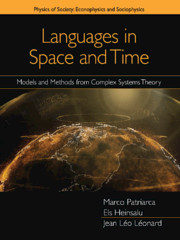Chapter 6 - Language Evolution Models
Published online by Cambridge University Press: 04 June 2020
Summary
All language dynamics models try to describe language change in one way oranother. There is no model that provides an exhaustive description of thedynamics of language, but each model tries to capture some relevant aspects.Any particular partitioning of language dynamics models into variouscategories is mainly a matter of convenience, as will become clear in thefollowing sections. Language change can concern very different features,from morphological and phonological to semiotic and cognitive ones; or itcan be observed as a language shift, a drastic form of language change inwhich a speaker adopts a new language in place of the former language; thetwo languages may not change appreciably during the shift.
Semiotic Dynamics models
Semiotic dynamics models (Castellano et al., 2009) owe theirname to the fact that these models study the change of (the semiotic sideof) a language, which is modeled as a set of couplings between words andobjects (Chandler, 1994, 2007). During the interactions among agents, someword–object couplings can be turned on or removed, leading to theappearance of new languages. Semiotic dynamics models study how a uniquelanguage can emerge within a group of interacting individuals initiallyspeaking different languages (Hurford, 1989; Oliphant and Batali, 1996;Castellano et al., 2009); the focus is on the mechanisms underlying theappearance of a consensus (Baronchelli, 2018). These models study neitherthe morphological changes nor the general cognitive changes, both names andobjects being considered as fixed entities, but how the links between themcan change in time.
The Nowak model
As the first example of a semiotic model, we consider the basic version ofthe Nowak model, which is an individual-based evolutionary language gamesimilar to Hurford's model (not described here, see see Hurford[1989]), which has been used to tackle different questions. The mechanismleading to consensus about a certain language used by a whole group ofspeakers is based on the reproductive success assigned to an individual whohas used a more successful communication strategy; eventually, only goodcommunicators remain in the population; in the long time limit, the bestcommunication strategy in the system is selected.
- Type
- Chapter
- Information
- Languages in Space and TimeModels and Methods from Complex Systems Theory, pp. 110 - 127Publisher: Cambridge University PressPrint publication year: 2020



